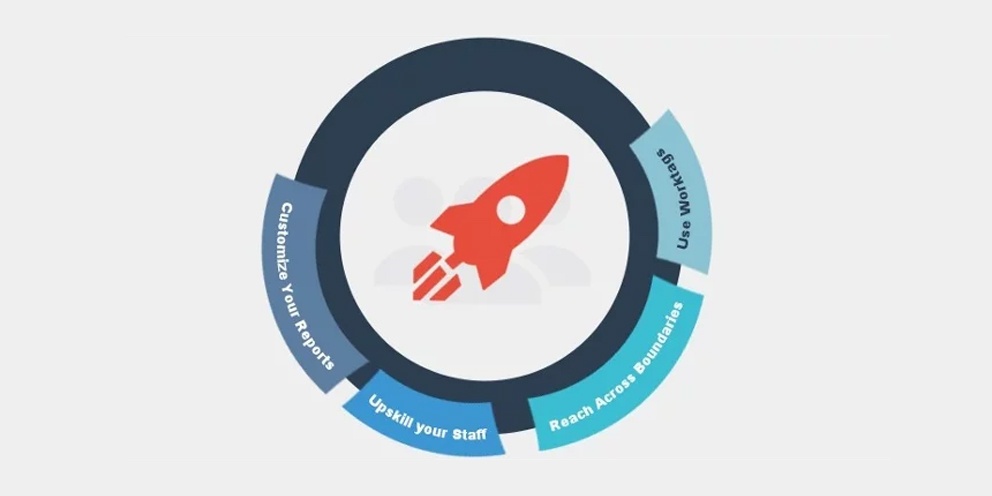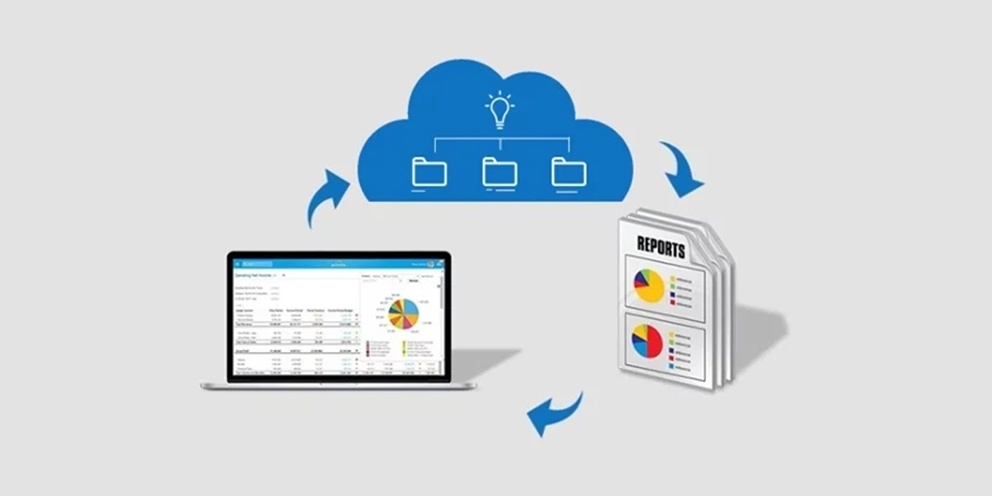
.jpg?width=992&name=workday%20(1).jpg)

From its beginnings, Workday®’s purpose has been to bring a unified Finance and Human Capital Management platform to customers to help them better manage their businesses.
In the organizations in which we worked with in the early days of automated financial reporting systems, HR and Finance were a mystery to each other. They didn’t like sharing information and erected organizational barriers that fostered isolation. Every need for information from one function to another created an extra burden for the department providing the information because we extracted, aggregated, and analyzed data on spreadsheets. It was a laborious process that took days or weeks.
Workday® disrupted all that when they created a cloud Financial system integrated with HCM. The in-memory, object-based architecture, a unified code base, and Composite Reporting make it possible to use business intelligence that was unavailable without expensive BI systems.
This functionality places reporting and analytics in your hands. Our four recommendations may help you get the most out of your Workday® Composite Reporting.
You need not hire a team of data scientists to get actionable business intelligence out of Workday®. A person with aptitude in spreadsheet formulas, pivot tables, and pivot charts will become adept at the mechanics of Workday® Composite Reporting in a short while. Take advantage of Workday®’s three-day Composite Reporting training.
Outsourcing your reports development is also an option. Your implementation partner or analytics consultant can help you over the short term as you build your ability.
Most of the value you get out of Workday® reporting lies in asking the right questions. In our experience, most of these information needs are related to the impact of HCM programs, projects, and learning activities on business results. Establishing results such as increased sales per employee as a result of a sales training program is simple. In other cases, you can use indirect results like revenue per employee, customer engagement, or cost per incident.
Congratulations if you already reached out across your organization to know what questions to ask. If you haven’t, reaching out to the leaders responsible for your company’s key performance indicators will pay off in understanding how other business functions perceive business results.
Workday®’s unified code base and Composite Reporting removed the structural obstacles to internal information sharing. If your organization still has policy barriers in place, it might be time to reexamine them. If your current security settings prevent you from analyzing organizational productivity and performance measures affected by HCM programs and initiatives, it will be worth the effort. Work with Finance to bring the walls down so you can better analyze the impact of your programs.
Financial systems are built on a Chart of Accounts: a list of every asset, liability, equity, revenue, and expense. Its purpose is to enforce structure on every transaction to make it possible to automate journal entries. It is a rigid structure, and in legacy ERP systems, expensive and time-consuming to adapt to changing business requirements. Worktags give you flexibility that doesn’t exist in traditional platforms.
The concept tagging is not new. We have worked with ERP clients since the mid-90s using flexfields to add descriptors to transactions and accounts. Most organizations found them somewhat useful, but inflexible. The time and expense of bringing them into the reporting infrastructure prevented clients from using them to their potential.
What makes Worktags different is the flexibility and ease of bringing them into reports. Program, project, and learning activity in Worktags can help you show the financial impact of your HCM initiatives to cut the guesswork.
Workday® provides many Standard Reports. They are useful, but we recommend you use them as templates to build your own.
First, you cannot use Standard Reports in web services to share data with other applications. Copy them into Custom Reports and enable web services. Not only will they be available for data integration, but web services enforces validation that makes the reports more stable.
Second, you and your staff will find the extra capabilities like calculated fields to be useful, and as your skills grow, your reports can grow with you.
Workday® Composite Reporting has brought a new dimension to human capital management reporting. We hope we helped you make the most of it.

Even though we are in the digital age and companies all over the world are using advanced analytics, almost all of business intelligence for day-to-day operations is operational reporting.
But without a robust library of reporting tools that deliver real-time actionable information, 88% of businesses still use spreadsheets to get the information they need. That was one of the key findings in a recent IFS study on enterprise software usability transformation. The report flatly states, “ERP means Excel Runs Production.”
Over the past few years, human capital management vendors have made a push to embed reporting tools in their applications, but they are just that — tools. Building a library of reports and dashboards that give you instant insights into your operations is a do-it-yourself project. This presents some difficult challenges for many businesses.
Your business can’t wait. You need access right now to the information that will help you make the right operational, tactical, and strategic decisions.
That’s why we’ve extended Chasma Analytics to Workday® human capital management.
Chasma Analytics provides preconfigured visualizations and dashboards, so you stop manipulating tabular reports or wrangling spreadsheets to analyze your operations. These visual reports give you instant insights and visibility into details without waiting for long development cycles.
Get the advantage of rapid deployment of business intelligence that can help you get the most from your Workday® human capital management.
Contact us for a demo.

Over time, Workday® users will create hundreds of reports. Without a disciplined and organized structure, they can quickly become a frustrating pain for users to find and for developers to maintain. A disciplined approach to reporting standards will save you a lot of trouble and expense.
There are many ways to categorize reports. You may be tempted to organize them by business function or organizational structure. We recommend you also think about the purpose of each report and who will be using it.
Once you have organized your reporting, you can apply tags and naming conventions to standardize the structure.
There are many ways to assign tags to reports. The tags that work for you will depend on your organization and how you operate. Here are some of the common ways.
Here is the best part: when you assign tags such as categories to reports, you can create worklets that make them easy to find. Instead of forcing your users to deal with long lists of reports, you can present short lists in your worklets. You can even create a dashboard of report worklets.
Standardizing report names is one of the most important things you will do. We strongly recommend you bring your reports developers together to agree on and enforce naming conventions. Here’s our list of best practices.
Here are a few other things you can do to make reports easier to manage.
Watch for our next article on Workday® reporting. We will be discussing tips for developers on how to manage calculated fields, web services, and other report design best practices.

In our careers in human capital management systems, most of us have come across situations where lax discipline in object names made the work harder. In one ERP implementation, an organization started with good intentions but didn’t follow up. They published well-structured rules for naming reports, business processes, integrations, and queries. They placed them in the training materials on their intranet and mentioned the rules in training.
Then they forgot about them.
Seven years later, the HR Director asked us to figure out how to get a meaningful reports from years of transactional data. The first assignment was to design a report that would tell him how many employees were in each employee group. That task took three weeks.
That’s an extreme case, but many organizations struggle when they do not create and enforce naming conventions. With a structured approach to governance and a few simple rules, you can save hours of frustration, lower your costs, and reduce unnecessary duplication.
One thing you notice first when you use Workday® is that its object names are plain language, not codes. You may need to learn word meanings, but you do not need a translation table. Learning is faster, and returning to operations you have not done for a while is much easier than when you had to relearn codes. When you set up Workday®, you can carry this concept into the objects you name.
You define and name many objects in Workday®. These include reports, business processes, integrations, encryption keys, calculated fields, and templates. You will gain much by following a set of naming rules. One of the primary benefits of consistent names is that you can find and reuse existing objects rather than re-create them.
A few best practices will help you avoid problems when you name your objects.
We recommend a governance process that will help compliance. You can do this with automated reports.
Naming conventions and governance should be a part of your implementation plan. However, it is never too late to get on the right track. Not only will you lower frustration among your Workday® users, but you also save your time and money in rework and duplication.
Pixentia is a full-service technology company dedicated to helping clients solve business problems, improve the capability of their people, and achieve better results.